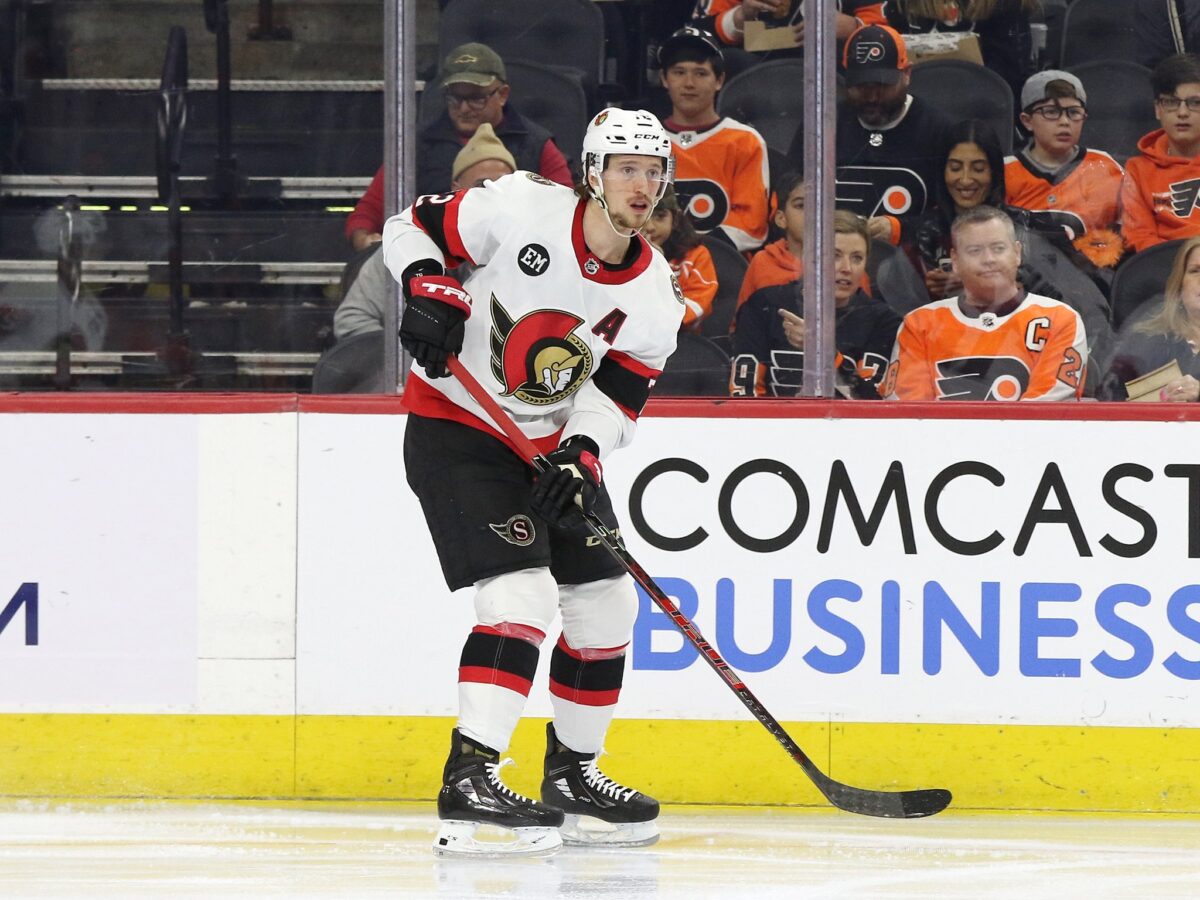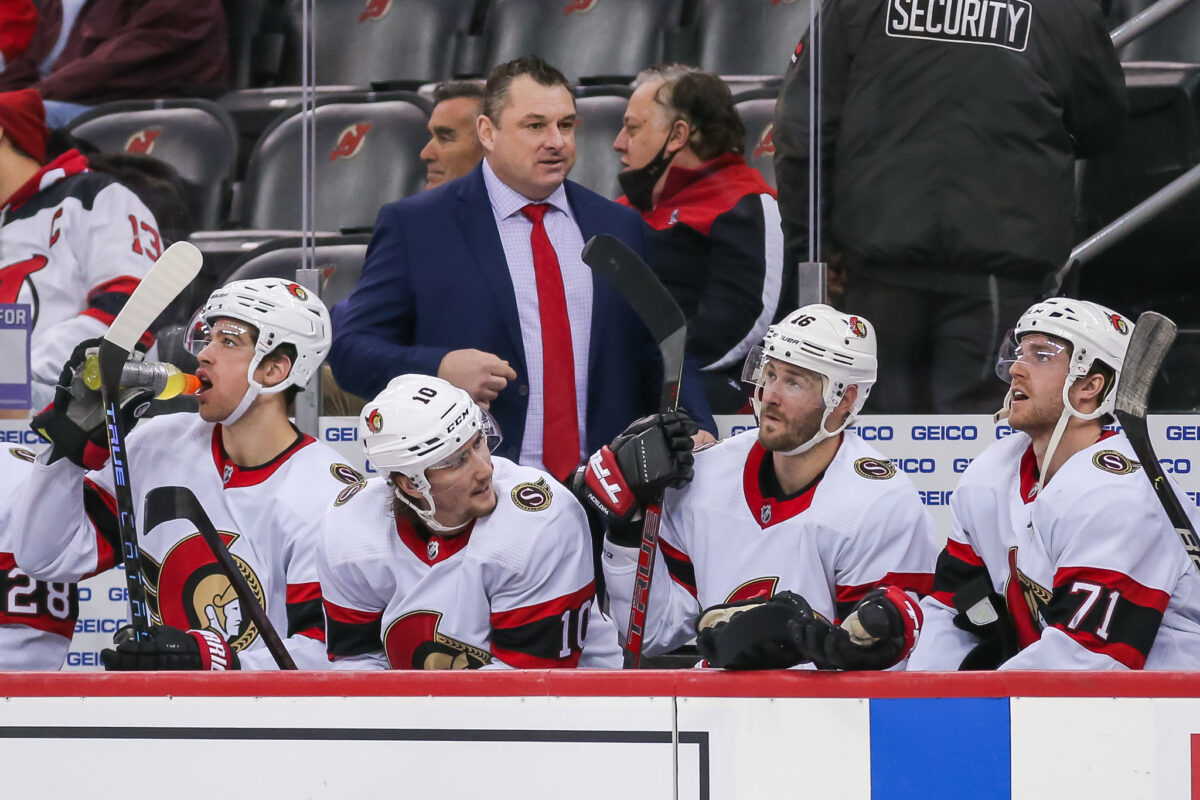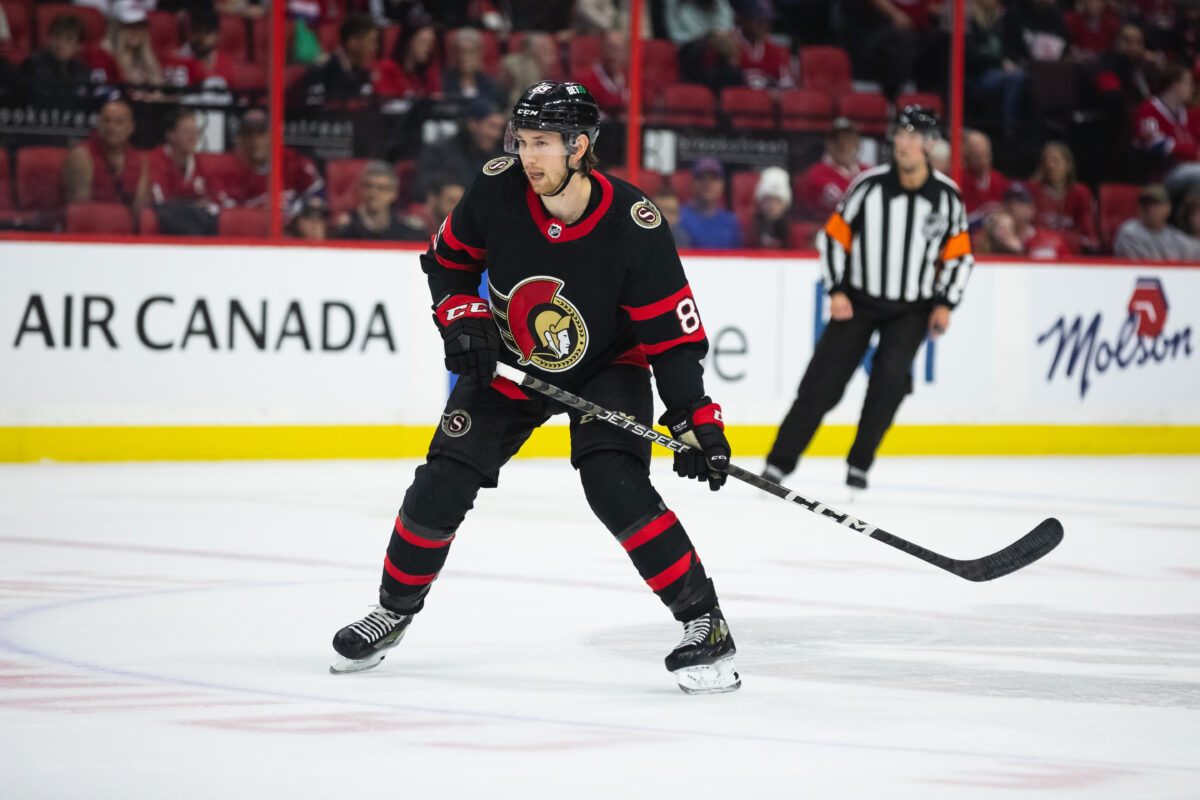It’s fair to say that no one expected the Ottawa Senators to be bottom-feeders again this season. After all, they signed Claude Giroux, traded for Alex DeBrincat and Cam Talbot, and still had the likes of Brady Tkachuk, Tim Stutzle, and Drake Batherson. But after a six-game losing streak, the team sits 30th in the league, well out of a playoff spot, and tensions are beginning to rise. Almost everyone is under the microscope, with some fans calling for coach D.J. Smith to be fired already, which general manager Pierre Dorion said isn’t happening any time soon.
While many of the team’s core players have been underwhelming so far this season, few players have been more disappointing than Thomas Chabot. The Senators’ best defenceman has struggled to be an impact player so far, scoring just two goals and five points in 12 games. That puts him on pace to hit 37 points this season, the lowest total of his career apart from the pandemic-shortened 2020-21 season, where he had 31 points in 41 games. Still, that’s a 60-plus point pace over a regular season.
Related: Senators’ 3 Up, 3 Down: Zaitsev’s Form, Chabot’s Ice Time & More
However, the blame shouldn’t fall solely on Chabot’s shoulders. Although his numbers are suspect, there are bigger issues at play on the team, many of which the blueliner has no control over.
Chabot Continues to Log Too Many Minutes
There’s no question that Chabot is playing too much right now. At the 21-game mark, he’s averaging over 25 minutes a night, which sits sixth in the NHL, which is a lot. But earlier in the season, he was well over 27 minutes, which would have placed him first. Against the Minnesota Wild on Oct. 27, he registered 27:16, then played a staggering 29:16 against the Florida Panthers two nights later. His minutes dropped down to around the 24-minute mark for the next three games, but against the Vancouver Canucks on Nov. 8, he was back up to nearly 30 minutes.

Yet, those numbers aren’t even the highest the 25-year-old defender has hit in his career. Over the past three seasons, Chabot has played an average of 26 minutes a night or more. Last season alone, he played over 30 minutes on five occasions, and in 2019-20, he hit an unbelievable 37:50 in an overtime loss to the Tampa Bay Lightning. Playing that much isn’t good; already, Chabot has struggled with injuries, largely due to his intense playing time.
This season, however, Chabot’s stats have started to dip. His defensive metrics are some of the worst on the team, as he currently sits second on the Senators’ defence in goals-against per 60 minutes with a 3.8 and on-ice save percentage with a dismal 86.6 percent, both of which are career lows. His offensive stats aren’t much better, though; among the team’s defencemen, he is fifth in both point shares and on-ice shooting percentage.
Something isn’t working. So why is Smith still putting Chabot out so often?
Trust Issues Between Smith and the Defence
Essentially, it comes down to trust. Smith trusts Chabot wholeheartedly for him to come up big in tough situations, and for the most part, he’s risen to the occasion. He’s been one of the team’s best possession players since joining the team permanently in 2017-18, driving play and making those around him better. He’s also competent defensively, and over the past three seasons, he’s had a 90 percent or greater on-ice save percentage. But it’s clear that he’s overworked, and Smith needs to start turning to other players to help him out.
That means that Chabot is often out on the ice when the team is losing to jump-start the offence or prevent the team from going down even further. Playing hard minutes in those situations will tank those stats. But even Smith acknowledges that he relies on his top defenceman too frequently, saying, “at times, we have played him too much when we’ve been trailing” (from ‘Senators season reaches crucial juncture: ‘It’s frustrating for everyone involved,’ The Athletic – 07/11/22).

“At times” may be a bit of an understatement. No other Senators’ defenceman is even in the same realm as Chabot when it comes to average ice time. Currently, Jake Sanderson has the second-highest ice time among Ottawa’s defenders, but he sits a full six minutes back at 19:07. After him is Travis Hamonic at 18:28, then Nick Holden all the way down at 16:32. Artem Zub was averaging nearly 22 minutes, but he’s been out since Oct. 28 with an upper-body injury, and it doesn’t look like anyone has taken his place.
It’s not uncommon for a defenceman to regularly log more than 25 minutes a night, but the teams that employ that strategy rarely rely so heavily on one player. The Canucks have three defenders who average over 20 minutes a game, with Quinn Hughes leading the pack at over 26 minutes a night. But Oliver Ekman-Larsson and Tyler Myers aren’t far behind, playing nearly 23 and 22 minutes each game. The Los Angeles Kings have a bigger gap between Drew Doughty, who also averages over 26 minutes a night, and the next two most-utilized defencemen. But Sean Durzi and Michael Anderson still play over 20 minutes on average.
Is the Senators’ Defence Actually That Bad?
It’s no question that the Senators’ defence is one of the weaker units in the league, which is why they’ve been tied in trade rumours to Jakob Chychryn for so long. Last season, they allowed the 11th most goals league-wide, which isn’t great. But at least it was an improvement from 2020-21 when they were fifth in goals allowed, though their overall plus/minus dropped from minus-33 to minus-39. Ottawa’s struggles have only been amplified by the absence of Zub; since he went on injured reserve, the Senators have allowed 26 goals in five games after allowing just 22 in the first seven.
However, some evidence suggests that the Senators’ defence isn’t quite as bad as first thought. In Micah Blake McCurdy’s model, the team’s expected goals against over 60 minutes should be just under three goals, which puts the team right in the middle of the pack. The biggest problem isn’t their effectiveness, but instead is their ability to give up crucial goals at the worst times.
Another issue has been defensive pairings. Individually, the Senators’ defence has been fine, but they don’t seem to work all that well together. For example, Chabot has played primarily with Erik Brannstrom, who has been quite good this season. He has a decent Corsi for percentage (CF%) of 55.8, nearly identical to Chabot, and leads the defence in Fenwick for at 55.5 percent. However, together, the pair have allowed nine goals over 66 minutes of ice time while generating just four goals.
Brannstrom isn’t a defensive defenceman, but he is a play driver similar to Chabot. His defensive awareness has been improving, but when the two are put together, they don’t have enough defensive abilities to prevent inopportune goals.
The Senators Have Options
Thankfully, the Senators have some options they can explore while they wait for Zub to get healthy. The best the team currently has is Sanderson. After Zub, he’s easily been Ottawa’s best defensive presence. In 12 games, he leads all active defensemen with an on-ice save percentage of 92.1 percent, a defensive point share of 0.7, and an expected plus/minus of 4.5. His first year on the Senators has been incredible, and he’s certainly bound for stardom. Smith would be foolish not to give them a longer look together.

However, Sanderson and Chabot have played just over 22 minutes together this season, so maybe there’s a reason Smith keeps them separated. That should force him to look to the second-best option in Jacob Bernard-Docker. A first-round pick from 2018, he’s finally starting to show some of his elite defensive abilities. Although he’s only played a single game in the NHL this season, he was able to record a 67.7 CF% and a 100% on-ice save percentage, both of which are team highs in 2022-23. While those numbers won’t last, it’s a great sign that he can be trusted to stop opponents and carry the puck out of the zone to create scoring chances.
Finally, there’s Hamonic. While not the ideal top-line partner, he’s at least a defensive-minded defender at this point in his career and has had some success with Chabot this season. Playing just 16 minutes together, the pair put up a goal and allowed just 10 shot attempts on net, none of which went in. Hamonic has a decent on-ice save percentage, as well, recording a 92.1 on-ice SV% over 12 games while averaging around 18 minutes a night.
Senators Need to Change Their Strategy…Fast
There is a real threat that this season could be a step back in the organization’s rebuild, which would have huge ramifications heading into the 2023 offseason. Would DeBrincat choose to sign an extension knowing the team can’t seem to figure out how to win games? Will the team be forced to make a bad deal for an average defenceman, much like the Hamonic trade last season? Or will a top prospect become a trade bait to bring in another top player who may not mesh well with the current core?
Something needs to change, and quickly. Smith needs to show that he trusts the rest of the defence beyond Chabot to play their part and start shifting pairings on the back end. A six-game losing streak is unacceptable with so much talent on the roster, even with some key injuries. And if the coach is unwilling to adapt, then it may lead to more drastic changes in the near future, regardless of what Dorion says.
All stats from hockey-reference.com. Line stats and combinations from frozenpoll.dobbersports.com.